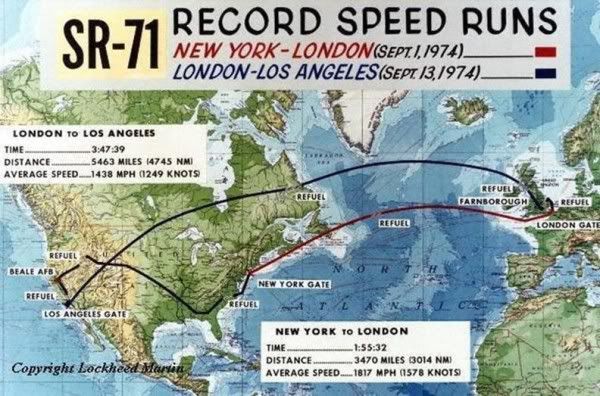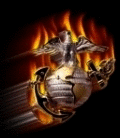"Be Quick, Be Quiet, And Be On Time"
That is a quote from a man with one of the greatest minds of our time. His name was Kelly Johnson. "Who the hell is/was Kelly Johnson?" you may ask yourselves. Here's a brief rundown:

The aircraft in the photo above was the brainchild of Johnson and the Skunk Works, and perhaps the greatest feat of aviation engineering of the 20th century, the SR-71 "Blackbird".
Here's a graphic depiction of some of it's record breaking runs:

So, what was it like to fly such an amazing aircraft? I'll let one of her pilots tell you.
*NOTE: After digging around to authenticate the following piece, I could find no record of a "Billy J. Foster" ever having been a "Habu" (the nickname given to the Blackbird by the residents of Okinawa, Japan upon first seeing the SR-71 in flight as it came and went from Kadena AFB, as it reminded them of the viper native to the island; the pilots adopted the name for themselves, also). I did, however, confirm that the RSO referred to as "Walt Watson" in the following piece was in fact the RSO for a Habu pilot named Brian Schul who wrote a book entitled "Sled Driver". Schul's biography in and of itself is no less amazing than that of the Blackbird and its creator.
While in the USMC, I had the pleasure of standing next to a Blackbird on display at the Tustin Air Show as I was part of the support crew from my squadron with our UH-1N "Huey" and AH-1W "Cobra" helicopters which seemed so insignificant compared to this mighty behemoth. I couldn't help noticing all the fluids leaking from the SR-71 - something that was cause for serious concern for us lowly, subsonic beings. However, we knew why this was normal for "the sled", as Schul explains.
Sadly, all good things must come to an end, and the "sled" and Johnson himself were not exceptions. Johnson passed away in 1990, the same year as the Blackbird was retired from service and Schul retired from the USAF. However, both Johnson and his bird left an incredible legacy.

PS - If you're as awestruck as I am about tis topic and the people involved, I really urge you, dear reader, to take the time to go through all the links.
Clarence L. "Kelly" Johnson came to Lockheed in 1932 hunting a job. He was turned down..insufficient experience. Johnson went back to school and obtained a Master's Degree in Aeronautical Engineering. He came to Lockheed again in 1933 and was hired as a tool designer. His salary was $83.00 per month and became the sixth Engineer working for the fledgling Lockheed Company. Then, as World War II approached, he helped the Company design the P-38, America's first 400 mph airplane. After assignments as flight test engineer, stress analyst, aerodynamicist, weight engineer, he became chief research engineer in 1938. In 1952, Johnson was named chief engineer of Lockheed's Burbank, California plant which later became the Lockheed-California Company. When the office of corporate vice president-research and development was established in 1956, he was chosen for the post. He became vice President-Advanced Development Projects (ADP) (Skunk Works) in 1958, a member of the board of directors in 1964 and a senior vice president of the corporation in 1969. He officially retired from Lockheed in 1975 but continued as a consultant to the Skunk Works and the Lockheed projects. Kelly left the Board of Directors in 1980. In June of 1983, the name of the 500 acre Lockheed Rye Canyon Research facility was renamed Kelly Johnson Research and Development Center, Lockheed-California Company, in his honor for 50 years of service to Lockheed.Read more about Kelly Johnson's amazing achievements and career.

The aircraft in the photo above was the brainchild of Johnson and the Skunk Works, and perhaps the greatest feat of aviation engineering of the 20th century, the SR-71 "Blackbird".
Here's a graphic depiction of some of it's record breaking runs:

So, what was it like to fly such an amazing aircraft? I'll let one of her pilots tell you.
*NOTE: After digging around to authenticate the following piece, I could find no record of a "Billy J. Foster" ever having been a "Habu" (the nickname given to the Blackbird by the residents of Okinawa, Japan upon first seeing the SR-71 in flight as it came and went from Kadena AFB, as it reminded them of the viper native to the island; the pilots adopted the name for themselves, also). I did, however, confirm that the RSO referred to as "Walt Watson" in the following piece was in fact the RSO for a Habu pilot named Brian Schul who wrote a book entitled "Sled Driver". Schul's biography in and of itself is no less amazing than that of the Blackbird and its creator.
The sled ride………….Here's some more from Schul, where he recounts, during that run over Libya, the unique bond that can exist between man and machine.
ByBilly J. Foster*Brian Schul
SR-71 Blackbird
In April 1986, following an attack on American soldiers in a Berlin disco, President Reagan ordered the bombing of Muammar Qaddafi's terrorist camps in Libya . My duty was to fly over Libya and take photos recording the damage our F-111's had inflicted. Qaddafi had established a 'line of death,' a territorial marking across the Gulf of Sidra , swearing to shoot down any intruder that crossed the boundary. On the morning of April 15, I rocketed past the line at 2,125 mph.
I was piloting the SR-71 spy plane, the world's fastest jet, accompanied by Maj Walter Watson, the aircraft's reconnaissance systems officer (RSO). We had crossed into Libya and were approaching our final turn over the bleak desert landscape when Walter informed me that he was receiving missile launch signals. I quickly increased our speed, calculating the time it would take for the weapons - most likely SA-2 and SA-4 surface-to-air missiles capable of Mach 5 - to reach our altitude. I estimated that we could beat the rocket-powered missiles to the turn and stayed our course, betting our lives on the plane's performance.
After several agonizingly long seconds, we made the turn and blasted toward the Mediterranean. 'You might want to pull it back,' Walter suggested. It was then that I noticed I still had the throttles full forward. The plane was flying a mile every 1.6 seconds, well above our Mach 3.2 limit. It was the fastest we would ever fly. I pulled the throttles to idle just south of Sicily, but we still overran the refueling tanker awaiting us over Gibraltar .
Scores of significant aircraft have been produced in the 100 years of flight, following the achievements of the Wright brothers, which we celebrate in December.. Aircraft such as the Boeing 707, the F-86 Sabre Jet, and the P-51 Mustang are among the important machines that have flown our skies. But the SR-71, also known as the Blackbird, stands alone as a significant contributor to Cold War victory and as the fastest plane ever-and only 93 Air Force pilots ever steered the 'sled,' as we called our aircraft.
There seems to be a confirmed trust now, between me and the jet; she will not hesitate to deliver whatever speed we need, and I can count on no problems with the inlets. Walt and I are ultimately depending on the jet now - more so than normal - and she seems to know it. The cooler outside temperatures have awakened the spirit born into her years ago, when men dedicated to excellence took the time and care to build her well. With spikes and doors as tight as they can get, we are racing against the time it could take a missile to reach our altitude.Read the whole story. It is fascinating, breath-taking, and as gripping and well written as any spy-thriller novel.
It is a race this jet will not let us lose. The Mach eases to 3.5 as we crest 80,000 feet. We are a bullet now - except faster. We hit the turn, and I feel some relief as our nose swings away from a country we have seen quite enough of. Screaming past Tripoli, our phenomenal speed continues to rise, and the screaming Sled pummels the enemy one more time, laying down a parting sonic boom. In seconds, we can see nothing but the expansive blue of the Mediterranean . I realize that I still have my left hand full-forward and we're continuing to rocket along in maximum afterburner.
While in the USMC, I had the pleasure of standing next to a Blackbird on display at the Tustin Air Show as I was part of the support crew from my squadron with our UH-1N "Huey" and AH-1W "Cobra" helicopters which seemed so insignificant compared to this mighty behemoth. I couldn't help noticing all the fluids leaking from the SR-71 - something that was cause for serious concern for us lowly, subsonic beings. However, we knew why this was normal for "the sled", as Schul explains.
Ironically, the plane was dripping, much like the misshapen model I had assembled in my youth. Fuel was seeping through the joints, raining down on the hangar floor. At Mach 3, the plane would expand several inches because of the severe temperature, which could heat the leading edge of the wing to 1,100 degrees. To prevent cracking, expansion joints had been built into the plane. Sealant resembling rubber glue covered the seams, but when the plane was subsonic, fuel would leak through the joints.As an engineer, I admire other, far greater engineers. Part of what was truly amazing and almost inconceivable is that Johnson and his Skunk Works team designed that bird in the days before computers and calculators. They did it with slide rules, ingenuity, and vision. They were products of the "old school" of education that valued knowledge over feeeelings and all the touchy-feely, left-wing, bullshit social "engineering" that goes on in today's indoctrination centers more commonly known as the public school system.
Sadly, all good things must come to an end, and the "sled" and Johnson himself were not exceptions. Johnson passed away in 1990, the same year as the Blackbird was retired from service and Schul retired from the USAF. However, both Johnson and his bird left an incredible legacy.
The SR-71 served six presidents, protecting America for a quarter of a century. Unbeknownst to most of the country, the plane flew over North Vietnam , Red China, North Korea , the Middle East, South Africa , Cuba , Nicaragua , Iran , Libya , and the Falkland Islands . On a weekly basis, the SR-71 kept watch over every Soviet nuclear submarine and mobile missile site, and all of their troop movements. It was a key factor in winning the Cold War.

PS - If you're as awestruck as I am about tis topic and the people involved, I really urge you, dear reader, to take the time to go through all the links.
Labels: Military









3 Comments:
That was an absolutely incredible bird. But you know they didn't retire it unless we've got something so far BEYOND it as to be unbelievable to the common man. I don't know what, but we've got something in the air.
Great post. Brings back a lot of memories.
I knew a Blackbird Pilot. They are real high-energy types -- he went through three wives that I know of.
Did you know that they shared the same training course as the astronauts?
My husband and I worked in aerospace defense research for our professional careers, so this is familiar stuff. In fact, his family was involved in the WWII aircraft industry from early days.
Hi, Nancy! Thanks for dropping by with some comments. I found out about Habu pilot training when I was researching this post. Brian Schul, who authored the quoted piece, was shot down and injured severely in Vietnam. He rehabbed and went through the training with no waivers which I found amazing in and of itself.
Blake, I often wondered if the SR-71 was actually de-commissioned at all, but I have to conclude that it was. And it was apparently replaced with our ultra-hi-tech satellite systems.
Post a Comment
<< Home